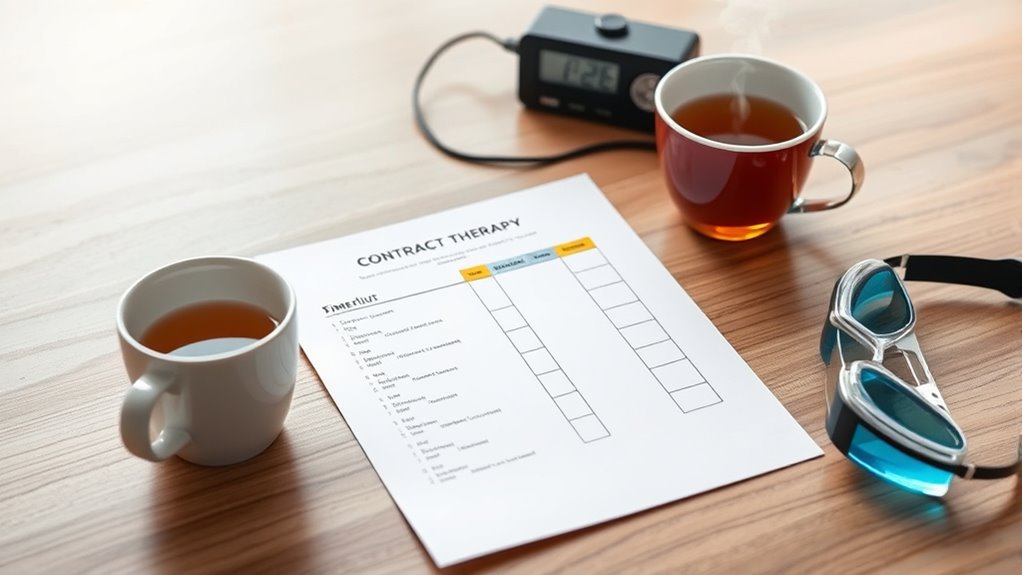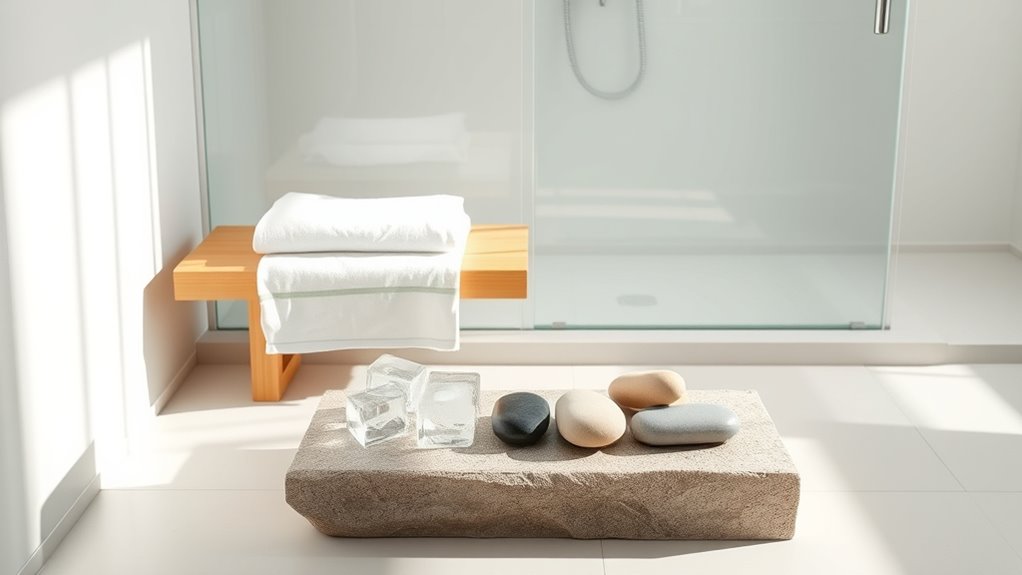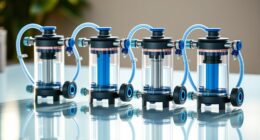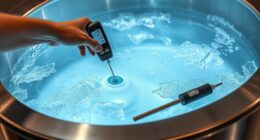Before starting contrast therapy, make certain you check the temperature of hot and cold sources to prevent burns or frostbite. Limit each exposure to 15-20 minutes and alternate treatments every 1-3 minutes, listening to your body’s signals. Stay well-hydrated and use barriers like towels to protect your skin. Monitor for discomfort or adverse reactions throughout. Following these safety steps helps you maximize benefits and avoid injuries—more details on proper timing and precautions await you.
Key Takeaways
- Ensure water or packs are at safe, comfortable temperatures before beginning, testing with your hand first.
- Limit each hot or cold exposure to 15-20 minutes, with alternating intervals of 1-3 minutes.
- Hydrate thoroughly before, during, and after treatments to prevent dehydration and support circulation.
- Space hot and cold treatments appropriately, typically starting with cold, then applying heat.
- Monitor your body’s signals, stopping immediately if you experience numbness, dizziness, or discomfort.
Pre-Treatment Safety and Timing Guidelines

Contrast therapy, which involves alternating between hot and cold treatments, can be highly effective for recovery and pain relief when timed correctly. But before you plunge into this practice, it’s essential to prioritize your safety and understand key factors like hydration importance and safety precautions. Proper hydration is vital because switching between hot and cold can cause your body to sweat or shiver, leading to fluid loss or dehydration if you’re not careful. Make sure you drink plenty of water before, during, and after your sessions to support circulation and help your body adapt to temperature changes. Staying well-hydrated also helps prevent dizziness or lightheadedness, common issues if your body isn’t properly fueled.
Safety precautions should never be overlooked. Check the temperature of your hot and cold sources before applying them to your skin—hot treatments should be warm, not scalding, and cold treatments should be icy but not painfully freezing. Always test the water or packs with your hand first. Never apply extreme temperatures directly to your skin, as this could cause burns or frostbite. Use a barrier, like a towel, between the hot or cold source and your skin if needed. Limit each session to specific durations—usually around 15-20 minutes for each temperature—and avoid overdoing it. Your body needs time to adjust to prevent shock or adverse reactions. Additionally, understanding industry trends and how they relate to your personal health goals can help you tailor your contrast therapy routine more effectively.
Timing is equally important. You should space out the hot and cold treatments properly; typically, alternating every 1-3 minutes is effective, ensuring you don’t overstress your system. For optimal results, start with a cold treatment to reduce inflammation, then switch to heat to promote blood flow and relax muscles. Keep in mind that your body’s signals are your best guide. If you experience numbness, excessive pain, dizziness, or discomfort, stop immediately. Listening to your body helps prevent injury and ensures your contrast therapy sessions are safe and effective.
Frequently Asked Questions
Can Contrast Therapy Be Combined With Other Recovery Methods?
Yes, you can combine contrast therapy with other recovery methods to enhance recovery synergy. Complementary modalities like stretching, foam rolling, or massage work well alongside contrast therapy. By integrating these techniques, you stimulate circulation, reduce soreness, and promote faster healing. Just guarantee you time each method properly and listen to your body. Combining strategies can optimize your recovery, making you feel better and ready for your next workout faster.
How Long Should I Stay in Each Temperature During Sessions?
You should stay in each temperature for about 1 to 3 minutes, following the suggested duration guidelines. Typically, you alternate between hot and cold, with temperature intervals that allow your body to respond without overdoing it. For cold, aim for around 10-15°C, and for hot, around 38-42°C. Always listen to your body, and if you feel uncomfortable, adjust the duration or temperature accordingly.
Is Contrast Therapy Suitable for All Health Conditions?
Contrast therapy isn’t suitable for everyone; you need to be aware of contraindications and do an individual health assessment first. If you have cardiovascular issues, skin conditions, or circulatory problems, it’s best to consult a healthcare professional before trying it. Knowing your health status helps prevent adverse effects. Always prioritize safety, and don’t ignore warning signs during therapy. Adjust sessions based on your personal health needs for the most effective and safe results.
What Are Signs of Adverse Reactions to Contrast Therapy?
You should watch for signs of adverse reactions to contrast therapy, such as increased pain, dizziness, or skin irritation. If you notice contrast sensitivity changes like numbness or tingling, or experience unusual fatigue, stop therapy immediately. Adverse reaction detection is vital, so pay close attention to how your body responds during and after sessions. If symptoms persist or worsen, consult a healthcare professional promptly.
How Often Should I Perform Contrast Therapy for Best Results?
You should perform contrast therapy 2 to 3 times a week for ideal results. Keep hydration tips in mind by drinking plenty of water before, during, and after each session. Focus on session duration by limiting each contrast cycle to about 10-15 minutes, alternating between hot and cold. Consistency and proper hydration help maximize benefits, reduce risks, and guarantee your body adapts effectively to the therapy.
Conclusion
Think of contrast therapy like a delicate dance, where timing and safety are your guiding steps. When you listen to your body and follow the checklist, you lead with confidence, avoiding missteps. Each session becomes a harmonious rhythm, balancing heat and cold like the ebb and flow of tides. Stay attentive, respect your limits, and let this dance restore and energize you, turning every treatment into a graceful movement toward wellness.









